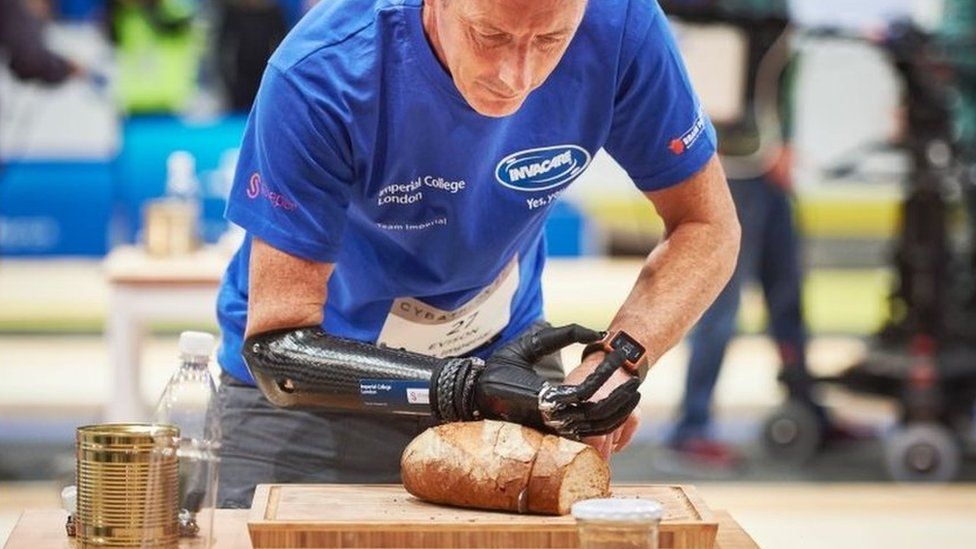Cybathlon: Battle of the bionic athletes
- Published

Bionic arms, robotic legs, powered exoskeletons, brain-controlled computer interfaces and supercharged wheelchairs - all took centre stage to compete at this weekend's Cybathlon.
Dubbed as the world's first "bionic Olympics", you might assume this to be a mini-Paralympics with some cutting-edge technology added to the mix.
But the focus of the event was less about athletics - and you could argue, less about competition - and more about what the future could hold for those with disabilities.
The competition was held near Zurich and saw a 4,600-strong crowd cheer on the innovation and hard work of 66 teams of technologists, developers and "pilots" - as the competitors were called - had put in.
It was a truly awe-inspiring display of assistive technologies that aim to overcome day-to-day practical challenges.
Opening a door towards you while in a wheelchair, for example. is currently tricky to do.
Likewise, climbing stairs with prosthetic legs is not easy, and many people find existing arm prostheses are not practical enough to be desirable to wear.
The contest featured a mix of devices that were newly designed and others that are already on the market.
Pilots with varying spinal cord injuries and bilateral leg amputations took on multi-terrain surfaces and stairs in powered wheelchairs.
The final descent from the steps was somewhat nerve-wracking to watch. What was probably carefully calculated physics looked like it could easily end in competitors taking nasty tumbles.
Some glided smoothly, others with a little more impact than appeared ideal.
One even braved the auditorium stairs, which, quite frankly, I'd found challenging in heels.
Another race saw functional electrical stimulation (FES) used to activate the leg muscles of paralysed "pilots" to ride bikes.
Some attached to the surface of the skin.
But one US team achieved this via actual implants.
Contestants' facial expressions showed focus, euphoria, occasional frustration and subsequent exhaustion - a mere glimpse at what this could actually mean for real-world use.
Cybathlon: The winners
The UK's highest placed entrant was Johnny Beer Timms, who took silver in the functional electrical stimulation bike race on behalf of Team BerkelBike.
But it was Switzerland and Iceland that had greatest success in the inaugural event, with a mix of teams taking back three medals apiece to each of the two countries.
The gold medal winners were as follows:
- Brain-computer interface race: Numa Poujouly - Team Brain Tweakers (Switzerland)
- Functional electrical stimulation bike race: Mark Muhn - Team Cleveland (US)
- Powered arm prosthesis race: Robert (Bob) Radocy - Team Dipo Power (Netherlands)
- Powered exoskeleton race: Andre Van Ruschen - Team ReWalk (Germany)
- Powered leg prosthesis race: Helgi Sveinsson - Team Rheo Knee (Iceland)
- Powered wheelchair race: Florian Hauser - Team HSR Enhanced (Switzerland)
Arm amputees used robotic prosthetic arms featuring hands in all shapes and sizes.
Some formed like a human hand, others were designed for function and easy grasping. They took on tasks including opening cans, changing light bulbs, slicing bread and hanging up clothes.
"The next challenge is the touch sensitive nature of the fingers," said Martin Wallace, development manager for Steeper, one of the companies producing robotic hands.
"There's no feedback at the moment on the commercial hands getting the signal back to the body - how hard someone is gripping something, or how hot something is, which you could feel with your actual fingers.
"So, getting that technology in would be ideal".
One event involved pilots with complete paraplegia - loss of motor and sensory function in their lower limbs - donning powered exoskeletons.
They had to put their full focus into getting up on their feet to embark on the course.
"It's like climbing a mountain or running a marathon", Philipp Wipfli, from Swiss team Varileg, said.
While a small boy in the audience voiced his disappointment that this was not like robots in the movies, to those over six, this was a fantastic feat of mankind.
Cybathlon's organisers, ETH Zurich and NCCR Robotics professor Robert Riener, have already achieved one of their goals: to spur on new conversations between technologists and those living with disabilities.
And after a day full of fighting spirit, optimism, excitement, and of course a few obligatory technical malfunctions, we have a taste of what the future could bring.
But making all the innovations reliable and financially viable for real world use may still take a bit of time.
More at BBC.com/Click and @BBCClick.
- Published12 September 2016
- Published10 October 2016